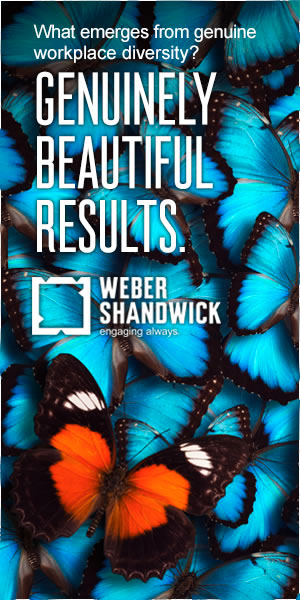In September, HiringSolved, a technology company that leverages artificial intelligence and machine learning to solve problems for talent acquisition practitioners, introduced RAI, an artificial intelligence assistant for recruiters.
The company states that HiringSolved makes it faster and easier to find the right person for any job.
“Our people aggregator gathers data from across the web and filters the most relevant information into a database of candidate profiles,” the website states. “With global coverage, all skill sets, the most advanced search capabilities on the market, and jaw-dropping speed, users are able to source the perfect candidate in seconds.”
 DIVERGE spoke to Jeremy Roberts, VP of Customer Experience at HiringSolved on how a software can help companies avoid discrimination and hire diverse candidates.
DIVERGE spoke to Jeremy Roberts, VP of Customer Experience at HiringSolved on how a software can help companies avoid discrimination and hire diverse candidates.
Can you explain the concept behind HiringSolved and why it’s so important?
HiringSolved is an aggregator of information about people. We index the world’s information as it pertains to people and consolidate it into unified profiles that recruiters can use to recruit. For example, as we gather data, we will find information that people have shared about themselves online in multiple locations.
Our machine learning algorithms verify that these bits of information belong to the same person and they are used to create a unified profile. A developers profile might contain information from places like Github, StackOverflow, Google+, About.me, and anywhere else they spend their time. Each profile is then given a diversity score. Rather than relying on specific schools or affiliations, which yield questionable results and which do not guarantee candidate diversity, we let mathematics do the heavy lifting. Diversity Search™ harnesses the power of Big Data to develop statistical models, which are used to analyze hundreds of data points per candidate to determine candidate diversity on the fly.
After a recruiter writes a search query, they can press one of the diversity boost buttons to bring candidates with a higher diversity score to the top of the results. This ensures that diverse candidates are shown at the top of the results so recruiters can focus on presenting a diverse candidate slate to hiring managers.
Where did this idea come from?
Our founder, Shon Burton, is a developer who previously owned a search firm. Much of what we do was previously done by Shon to fill searches for his clients. The diversity search piece is something that our clients all need and many have requested.
What are you automating?
When a recruiter is trying to identify candidates who haven’t reached out to them for a job, they visit multiple websites to gather whatever data they can about a candidate. They then try to find contact information so they can engage with them. If diversity is important, they’re stuck trying to guess who is diverse and who isn’t. We’ve automated the aggregation of disparate profiles and provide recruiters a way to get in touch with candidates. The diversity boost feature allows for recruiters to leverage data, mathematics, and statistics to rearrange search query results so diverse candidates are at the top of the results.
How can this help avoid discrimination?
There is only one sure-fire way to increase workforce diversity: Put more diverse candidates into the interview pipeline. HiringSolved’s Diversity Search™ enables sourcers and recruiters to increase candidate diversity where it matters most, in the top of the hiring funnel. A more diverse candidate pool means a more diverse workforce.
Diversity thoughts from Shon Burton, founder of HiringSolved:
 From my perspective diversity challenges start at the top of the hiring funnel. For example, when I was recruiting for Google, my contract was to put 100 engineers in front of them per month that they weren’t already talking to. The number of women submitted in those 100-candidate batches was always less than 5%. This was not because we were screening women out, but because we weren’t specifically looking for them. If you want to move the needle on diversity, you have to align both the process and the technology to make that happen. The simple math says that there are less women than men in this field, therefore you need to apply extra effort to get diverse candidates into the hiring funnel (interview pipeline) in the first place.
From my perspective diversity challenges start at the top of the hiring funnel. For example, when I was recruiting for Google, my contract was to put 100 engineers in front of them per month that they weren’t already talking to. The number of women submitted in those 100-candidate batches was always less than 5%. This was not because we were screening women out, but because we weren’t specifically looking for them. If you want to move the needle on diversity, you have to align both the process and the technology to make that happen. The simple math says that there are less women than men in this field, therefore you need to apply extra effort to get diverse candidates into the hiring funnel (interview pipeline) in the first place.
Diverse teams work better. That’s a proven fact. The need to create technology that quickly and easily highlights diverse talent is being driven by demand from our customers. We’re often dealing with Global 2000 companies that have strong initiatives to hire a diverse workforce. The question becomes how do they actually accomplish that goal. It can be a big challenge because competing for talent is already a massive task. That’s where new technology like RAI will help by highlighting diverse candidates automatically.
Companies like Google are now committed to moving the diversity needle. In Google’s case they publicly committed to achieving more than 17% women in their engineering workforce. Given the fact that there are more men than women working in the space, they will need to expend extra effort to bring women to the front of the talent search. To accomplish this, they will need consider women “more relevant” than men in this particular case. This type of search relevance is exactly what our diversity technology does. Without this technology, a recruiter would need to manually search for diverse signals, for example searching for a required skill in addition to a sorority, would be a manual way to accomplish this, but this type of search is complex and very labor intensive. RAI uses social signals and many other data points to do this automatically.


